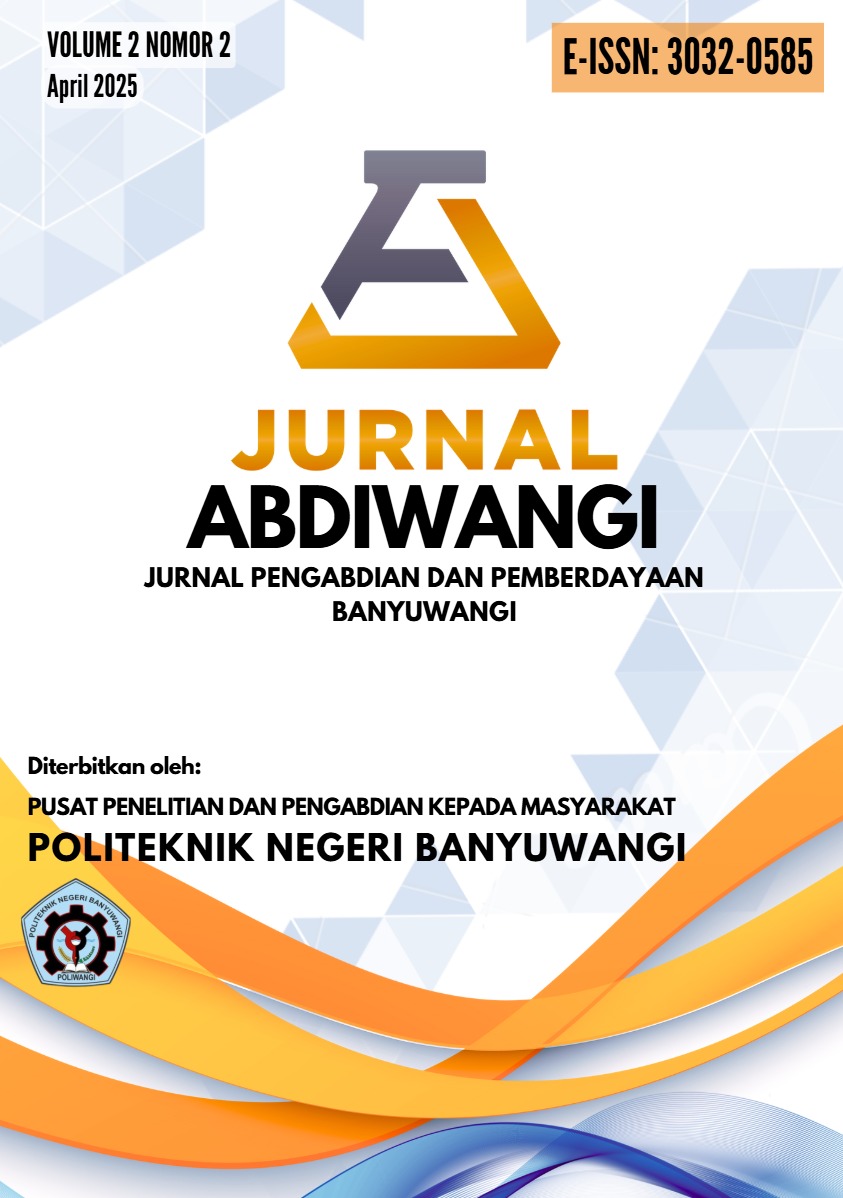Training to Improve Hijaiyah Letter Writing Skills for Early Childhood at TPQ Baiturrahman.
DOI:
https://doi.org/10.57203/abdiwangi.v2i2.2025.115-124Keywords:
Training, Writing Skills, Arabic Alphabet, Early ChildhoodAbstract
Community service through a mentoring program for writing hijaiyah letters at TPQ Baiturrahman. Education is a form of conscious effort to change circumstances. From not knowing to knowing. Education has an important role, especially in the progress of the nation. Education is the main center in the formation of national cadres. No exception for religious education. Religious education is an important education for every individual. Learning activities at TPQ are relatively the same as Islamic boarding schools. The difference is that if at TPQ students leave from home, then at Islamic boarding schools students are domiciled. The PKM method used in the study uses the INPO method, namely (input-process-output). The INPO method is divided into three stages, namely the input stage, the process stage, and the output stage. The INPO method is a method that combines field research with qualitative and quantitative, based on the mentoring activities for the ability to write hijaiyah letters at TPQ Baiturrahman running smoothly with a very effective level of understanding of 20% and an effective 80% meaning that this activity was maximally successful.
References
[1] S. Supriyaddin, M. N. I. Imansyah, and L. M. Meilani, “Pengembangan Aplikasi Pembelajaran Pengenalan Huruf Hijaiyah Pada Tingkatan Sekolah Dasar Menggunakan Macromedia Flash,” Ainara Journal (Jurnal Penelitian dan PKM Bidang Ilmu Pendidikan), vol. 1, no. 1, pp. 1–7, Nov. 2020, doi: 10.54371/ainj.v1i1.7.
[2] A. Wapa, A. Wijaksono, and T. Moh Yusuf, “Penerapan (Tabel Pejumlahan Pintar) TAPEntar Terhadap Pembukuan Keuangan Usaha Tape Di Desa Pakem Bondowoso Application (Smart Addition Table) of TAPEntar to Financial Bookkeeping of Tape Businesses in Pakem Village Bondowoso,” vol. 1, no. 2, 2024, doi: 10.57203/abdiwangi.v1i2.2024.94-102.
[3] A. Arifin, F. Ma’ruf, and I. Yasin, “Efektivitas Belajar Al-Qur’an Dengan menggunakan Aplikasi Hijaiyah Berbasis Budaya Lokal ‘Nggahi Mbojo’ (Bahasa Bima) Pada Lansia di Kabupaten Dompu,” Ainara Journal (Jurnal Penelitian dan PKM Bidang Ilmu Pendidikan), vol. 1, no. 1, pp. 24–30, Nov. 2020, doi: 10.54371/ainj.v1i1.10.
[4] M. Haramain, “Menimbang Perspektif Perennial Philosophy dalam Studi Lintas Agama: Potret Pemikiran Sayyed Hossein Nasr dan Frithjof Schuon.,” pp. 1–13, 2014.
[5] S. A. Rachman, M. Muhibbin, and H. Wathan, “Pengenalan Huruf Hijaiyah Melalui Penggunaan Media Audio Visual Di Tk Anak Bangsa Lombok Tengah,” Insanta : Jurnal Pengabdian Kepada Masyarakat, vol. 1, pp. 40–43, Oct. 2023, doi: 10.61924/insanta.v1i2.11.
[6] M. D. Ika 1), Ninda Nurfattah Zahra2), Riani Nur Azizah3), “Metafisika Dan Metode Ilmiah Menjelajahi Agama Dan Sains,” vol. 2, no. 1, pp. 84–89, 2024.
[7] Rosyida Nurul Anwar, “Pendidikan Alquran (TPQ) Sebagai Upaya Membentuk Karakter Pada Anak,” 2021. Accessed: Jul. 28, 2025. [Online]. Available: JPdK Volume 3 Nomor 1 Tahun 2021 Halaman 44-50 JURNAL PENDIDIKAN dan KONSELING Research & Learning in Primary Education
[8] H. Abdul Malik, K. Kunci, and T. Pendidikan Al-Quran, “Pemberdayaan Taman Pendidikan … Pemberdayaan Taman Pendidikan Al-Quran (Tpq) Alhusna Pasadena Semarang,” 2013.
[9] A. Wapa, “Penerapan ( Tabel Pejumlahan Pintar ) TAPEntar Terhadap Pembukuan Keuangan Usaha Tape Di Desa Pakem Bondowoso,” vol. 1, no. 2, pp. 94–102, 2024, [Online]. Available: https://doi.org/10.57203/abdiwangi.v1i2.2024.94-102
[10] I. Mailani, “Inovasi Pembelajaran Pendidikan Agama Islam Berbasis Pr o b l e m Bas ed L earn in g,” Al-Uswah: Jurnal Riset dan Kajian Pendidikan Agama Islam, vol. 1, no. 2, pp. 129–137, 2019, doi: 10.24014/au.v1i2.
[11] N. N. K. Sari, “Rancang Bangun Media Pengenalan Huruf Hijaiyah Untuk Anak Usia Dini Berbasis Android,” Jurnal Teknologi Informasi: Jurnal Keilmuan dan Aplikasi Bidang Teknik Informatika, vol. 14, no. 2, pp. 161–170, Aug. 2020, doi: 10.47111/jti.v14i2.1214.
[12] Mira Shodiqoh, “ILMU RASM QURAN,” Tadris : Jurnal Penelitian dan Pemikiran Pendidikan Islam, vol. 13, no. 1, pp. 91–101, Nov. 2019, doi: 10.51675/jt.v13i1.56.
Downloads
Published
Issue
Section
License
Copyright (c) 2025 Andi Wapa, agus wijaksono, Uswatun Hasanah , Achmad Faruq Dzia Uddin

This work is licensed under a Creative Commons Attribution 4.0 International License.
Jurnal ini menyediakan open access yang pada prinsipnya membuat riset tersedia secara gratis untuk publik dan akan mensupport pertukaran pengetahuan global.





